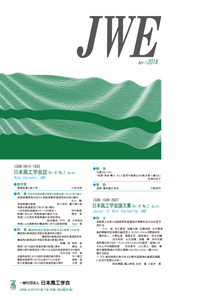All issues

Volume 41, Issue 2
[No. 147]
Displaying 1-4 of 4 articles from this issue
- |<
- <
- 1
- >
- >|
Technical Paper
-
Ryo OGAWA, Keisuke YOSHIE, Daiki SATO, Toshiaki SATO, Haruyuki KITAMUR ...Article type: Technical Paper
2016Volume 41Issue 2 Pages 41-47
Published: April 30, 2016
Released on J-STAGE: May 17, 2016
JOURNAL FREE ACCESSRecently, response evaluation of a high-rise seismic isolated building against the wind external force within elasto-plastic range has been requested. In the elasto-plastic response case, shifts of center displacement which are showing change in very long period like a step-function are caused. The response time history is separated to resonance component and quasi-static component and examined. From the time history analysis results, we could verify that the shift of the change center displacement is caused by the resonance component. This paper proposes a prediction method for quasi-static component response caused by the shifts of center displacement of a high-rise seismic isolated building under the fluctuation wind force. Its accuracy is demonstrated through comparison with time history analysis results.View full abstractDownload PDF (1150K) -
Taketo MIZOTA, Hiroki OGURI, Takeshi NARUO, Tatsuya TAKATSUKA, Yuusuke ...Article type: Technical Paper
2016Volume 41Issue 2 Pages 48-57
Published: April 30, 2016
Released on J-STAGE: May 17, 2016
JOURNAL FREE ACCESSAerostatic bearing load cell which is available to measure 3-components aerodynamic forces and torque is developed. Each table to detect the forces is floating by air pressure and balanced by a pair of coil springs. The model in the wind tunnel is connected with fine piano wires to a light frame on the unit. The wind loads acting on the model shift the each table within short distances. These shift magnitudes are measured with laser displacement devices. Aerodynamic torque is counted by spinning decay ratios of the model. As a result, this load cell has some specific characteristics to measure the forces, such as good linearity, high resolution, less interference and less temperature drift. The validity of this new apparatus is shown by the aerodynamic forces and torque measurements on highly spinning golf ball.View full abstractDownload PDF (1527K) -
Jumpei YASUNAGA,, Takayuki YAMAGUCHI, Yasushi UEMATSUArticle type: Technical Paper
2016Volume 41Issue 2 Pages 58-67
Published: April 30, 2016
Released on J-STAGE: May 17, 2016
JOURNAL FREE ACCESSThe present paper investigates the buckling and vibration behavior of open-topped oil-storage tanks under wind loads based on a finite element analysis. Focus is on the effects of wind girders on such behavior. The wind force coefficients obtained in a turbulent boundary layer is used in the analysis. From the results of buckling analysis, the effects of top/intermediate wind girders on the buckling load and mode of tank shells are made clear. Furthermore, the effect of wind force distribution on the buckling load is discussed based on the results obtained from wind tunnel experiments with two or three tank models in in-line arrangement. A time-history analysis is also carried out in order to investigate the effect of the rigidity of wind girders on the vibration of tank shells. The stresses involved in the tank walls are found to be fairly small, provided that the wind girders are relatively rigid. Finally, the design recommendations of wind girders installed on an open-topped oil storage tanks are proposed, which provide more reasonable design criteria for the wind girders than the current guidelines.View full abstractDownload PDF (1511K) -
Hirotsugu OKADA, Kyosuke HIYAMA, Ken MATSUDA, Makoto KOGANEIArticle type: Technical Paper
2016Volume 41Issue 2 Pages 68-78
Published: April 30, 2016
Released on J-STAGE: May 17, 2016
JOURNAL FREE ACCESSToday, the use of CFD analysis has increased in architectural and environmental fields. Visualization of information from simulation outputs can help teams and clients understand the direction of projects well. However, it often runs the risk of careless output of simulation results and thereby leads to misunderstanding. Therefore, information entropy in visualized information needs to be reduced. The factors that affect the understanding of visualized information have been studied through two experiments. In the first experiment, participants examined pictures of wind fields around buildings as the outputs of a CFD analysis. The color scheme strongly affects their understanding about the wind fields and a reverse color scheme makes them feel that it is windier. In the second experiment, it was found that not only does the color scheme in the strong wind area, but also the one in the weak wind area, affects their understanding of visualized information.View full abstractDownload PDF (2901K)
- |<
- <
- 1
- >
- >|